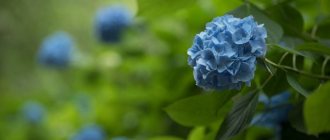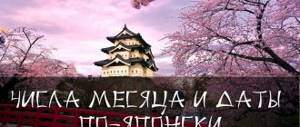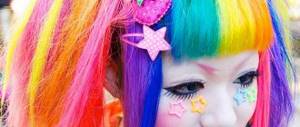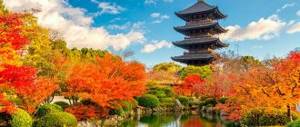There are flowers in Japan that are especially beloved by the Japanese. They are also the main characters of traditional hanami (and not only), flowers that have their own special meanings, names, poetic nicknames, myths and legends. Here are some of them:
Sunflower / Himawari
The Japanese name for sunflower is Himawari . The color yellow in Japan is associated with the end of summer, representing the life-giving forces of the elements, the earth. It also embodies the idea of "center", balance, order. Yellow flowers are given to those whom they wish goodness and prosperity. In Japan, specially bred ornamental sunflower varieties are planted “for beauty.”
PLUM
Plum blossoms mark the start of early spring, but the trees begin to bloom in mid-February and remain in full bloom until mid-March. According to ancient tradition, this is the first flower that appears in the new year, because previously the beginning of spring was considered the beginning of the year. Unlike sakura, plum flowers have a pleasant, intense scent. The sight of white, dark pink, light pink and even yellow flowers under the snow evokes a special thrill in the Japanese soul. To enjoy the view of plum blossoms, you can visit the Kairakuen Garden (Mito), Yushima Tenjin Shrine (Tokyo), and Atami Plum Garden (Shizuoka).
Hydrangea / Hydrangea / Ajisai
Japanese name Ajisai . Most types of hydrangea are shrubs 1-3 m high. The flowers are collected at the end of the stem in spherical inflorescences. The most popular large-leaf hydrangea (more than 600 varieties) has flowers that can be white, blue, lilac, pink, red (depending on the acidity of the soil). In Japan, the peak flowering time for hydrangeas is the rainy season (mid-June). Around many temples and shrines there are many hydrangea bushes (sometimes up to 150 thousand): Meigetsu-in in Kamakura, Fujimori Jinja, Tofukuji in Kyoto. , Hydrangea Festivals (Ajisai Matsuri) are held in shrines and parks in Japan
Sunflower / Himawari
The Japanese name for sunflower is Himawari. The color yellow in Japan is associated with the end of summer, representing the life-giving forces of the elements, the earth. It also embodies the idea of "center", balance, order. Yellow flowers are given to those whom they wish goodness and prosperity. In Japan, specially bred ornamental varieties of sunflowers are planted “for beauty.”
Cosmea / Cosmos / Cosmos
Heat-loving annual plant of the Asteraceae family. Blooms from mid-summer to autumn. Flowers with a diameter of 7-10 cm. In Japan, space is the object of hanami (flower admiration) in the summer.
Hydrangea / Hydrangea / Ajisai
Japanese name Ajisai. Most types of hydrangea are shrubs 1-3 m high. The flowers are collected at the end of the stem in spherical inflorescences. The most popular large-leaf hydrangea (more than 600 varieties) has flowers that can be white, blue, lilac, pink, red (depending on the acidity of the soil). In Japan, the peak flowering time for hydrangeas is the rainy season (mid-June). Around many temples and shrines there are many hydrangea bushes (sometimes up to 150 thousand): Meigetsu-in in Kamakura, Fujimori Jinja, Tofukuji in Kyoto. During the flowering season, Hydrangea Festivals (Ajisai Matsuri) are held in shrines and parks in Japan.
Licorice / Higanbana
Lycoris (Higanbana), Latin name – Lycoris radiata (bulbous plant of the amaryllis family). It originates from Greek mythology - the Nereid Lycoris was famous for her beauty. In English, the names Red Spider Lily and Hurricane Lily are often used because they bloom before the hurricane season. In Japanese, the main name of this flower is Higanbana. It blooms in September - just in time for the autumn equinox - Higana (Aki no Higan). Despite the beauty of the flower, lycoris is not planted near houses - it is a flower dedicated to the dead. He loves to grow up on the battlefields where the blood of warriors was shed.
Traditionally, lycoris is planted in cemeteries (not only as decoration, but also for protection from animals due to its toxicity). It is believed that if you bring flowers into your home, it may cause a fire. But the Japanese specifically planted lycoris on the borders of rice fields. Firstly, the bulbs strengthened the soil, preventing it from weathering and being washed away by water. In addition, poisonous plants protected crops from rodents. And finally, during crop failure, the bulbs and stems were eaten (the poison could be washed out with plenty of water). Lycoris stems emerge from the ground in autumn and bear bright red flowers. Then the flowers fade and leaves appear, which remain until the beginning of summer. So flowers and leaves can never be seen together.
Lycoris has many other names: shibito-bana - “flower of the dead”, yuurei-bana - “flower of ghosts”, tengai-bana - “flower that looks like tengai” (decoration of the dome of a Buddhist temple), yome no kanzashi - “flower which is similar to the kanzashi (traditional hairpin) of the bride”, doku-bana – “poisonous flower”, manjushage (in Sanskrit – “manjusaka”) – “heavenly flower” (in Buddhist sutras there is a mention of red flowers falling from the sky, bringing joy) , jigoku-bana – “hell flower”, kamisori-bana – “razor flower”, kizune-bana – “fox flower”. So mysterious and ambiguous. In Korea, lycoris was given the name “san cho” - “flowers miss leaves, and leaves miss flowers.”
Wisteria / Wisteria / Fuji
The Japanese name Fuji is a genus of deciduous vines. They grow naturally in China, Korea and Japan, as well as in the southeastern regions of the United States. The most famous are Chinese and lush-flowering (or Japanese) wisteria. The liana can climb up to 20 meters, twisting around the trunk of a supporting tree or artificial support. Wisteria blooms in spring or in the first half of summer (depending on the species). Inflorescences of fragrant flowers of lilac, white, pink, blue can be up to 1 meter in length. Wisteria is used in landscape design. At festivals, it is often used to decorate floats or “flower umbrellas.”
Camellia / Camellia / Tsubaki
Japanese name Tsubaki. Belongs to the tea family. In Japan (and beyond), the most famous is the Japanese Camellia (Camellia japonica), which originates from Southwestern China. Wild camellia is an evergreen shrub 6-9 meters high with red flowers 5-8 cm in diameter, having five to six petals and dense stamens. Many hybrids of red, pink, cream and other colors have also been bred. Some of them are double, similar to roses or peonies. One of the names of camellia is “winter rose”. In areas with a mild climate, it can bloom in the middle of winter; the flowering period is 4-5 months. Camellia is widely used for landscaping parks, gardens and indoors.
Sakura / Sakura
Sakura (Japanese – Sakura) – Japanese cherry. Wild sakura grows in China, Korea and Japan, but in Japan new varieties have been bred for a long time (there are several hundred of them). The most popular type of sakura is Somei Yoshino. Its petals are pure white, only slightly pinkish at the base of the flower. Fuyuzakura - winter sakura begins to bloom in the fall, and sometimes also in winter. Yaezakura has large flowers with dark pink petals. Shidarezakura (weeping cherry) has long branches hanging down with a cascade of pink flowers. Small sakura fruits are not eaten. In cooking, salted or pickled flowers are used (to add flavor to dishes), as well as leaves in which sakura-mochi, sweet rice balls with sweet bean paste, are wrapped.
Tokkobana – kamikaze flower / Ookinkeigiku / Tokkobana
Coreopsis. The Japanese call this flower Ookinkeigiku, which means chicken chrysanthemum. Coreopsis belongs to the Asteraceae family; its relatives are the well-known chamomile, dandelion, aster and sunflower. This is a perennial herbaceous plant, branched stems up to 60 cm tall. The leaves are petiolate, lanceolate or almost linear, and disappear as they climb up the stem. The reed flowers range from golden yellow to dark yellow and bloom very beautifully from July for about two months. The plant loves sunlight, and in Japan it can often be seen along airfield runways. In the Land of the Rising Sun there is a second name for this flower; the Japanese call it Tokkobana, which means “kamikaze flower”.
This flower, found in Kagoshima Prefecture, is called tokkobana in Japanese. Tokkobana literally means "special attack flower", but the word can also be translated as "kamikaze flower". According to legend, they appeared here because these flowers were dropped by kamikaze pilots from their planes as they flew over Mount Kaimon over the southernmost point of mainland Japan on their way to Okinawa. In addition, yellow tokkobana blooms profusely in May and June near the runway of Kanoya Air Base, which served as the base for the largest number of suicide pilots during the war. When these flowers appeared in Japan remains a mystery. There are several assumptions. The most plausible theory is that planes returned to base during World War II and carried flower seeds on their wheels. Others believe that the pilots, who were 18-20 years old, still children by and large, loved the beauty of nature and brought the flowers themselves.
Tokkobana flowers play a central role in the television film A Moon Twenty-six Days Old by Y. Mairi. Three young kamikaze pilots check into a small hotel on the eve of their flight and become friends with an eight-year-old girl at the inn. When they leave in the morning, the girl gives each of them a bouquet of yellow tokkobana flowers, which the three pilots drop on the lower slopes of Mount Kaimon, where today there is a huge field of these flowers.
Licorice / Higanbana
Licorice is blooming - and it is impossible to die at such a time. (c) Taneda Santoka
Lycoris ( Higanbana ), Latin name – Lycoris radiata (bulbous plant of the amaryllis family). It originates from Greek mythology - the Nereid Lycoris was famous for her beauty. In English, the names Red Spider Lily and Hurricane Lily because they bloom before the hurricane season. In Japanese, the main name of this flower is Higanbana . It blooms in September - just in time for the autumn equinox - Higana (Aki no Higan) .
But besides this, lycoris has many more names: shibito-bana - “flower of the dead”, yuurei-bana - “ghost flower”, tengai-bana - “a flower that looks like tengai” (decoration of the dome of a Buddhist temple), yome no kanzashi - “a flower that looks like the kanzashi (traditional hairpin) of the bride”, doku-bana - “poisonous flower”, manjushage (in Sanskrit - “manjusaka”) - “heavenly flower” (in Buddhist sutras there is a mention of red flowers falling from the sky, bringing joy), jigoku-bana – “hell flower”, kamisori-bana – “razor flower”, kizune-bana – “fox flower”. So mysterious and ambiguous. And everything would be fine, and they look beautiful, but lycoris is not planted near houses - it is a flower dedicated to the dead. He loves to grow up on the battlefields where the blood of warriors was shed. Traditionally, lycoris is planted in cemeteries (not only as decoration, but also for protection from animals due to its toxicity). It is believed that if you bring flowers into your home, it may cause a fire. But the Japanese specifically planted lycoris on the borders of rice fields. Firstly, the bulbs strengthened the soil, preventing it from weathering and being washed away by water. In addition, poisonous plants protected crops from rodents. And finally, during crop failure, the bulbs and stems were eaten (the poison could be washed out with plenty of water). Lycoris stems emerge from the ground in autumn and bear bright red flowers. Then the flowers fade and leaves appear, which remain until the beginning of summer. So flowers and leaves can never be seen together. In Korea, lycoris was given the name “san cho” - “flowers miss leaves, and leaves miss flowers.”
Japanese flowers
Japan is an amazing country with its parks and squares created according to the ancient traditions of Japanese art. It is in this country that the concept of hanami - admiring flowers - exists. The Japanese respect flowering plants, admiring their beauty and aroma. Any tea ceremony is accompanied by table decoration with a composition of flowers.
The nature of this amazing country also comes to the aid of local residents when growing them. Lots of sun, moisture, and a mild climate make it possible for many rare plants to grow and flourish. In addition, the Japanese not only plant flowers everywhere, but strive to increase the flowering period, develop plants of unusual colors, and increase their volume and splendor. It is not for nothing that there is a statement that Japanese flowers are the most beautiful.
Wisteria / Wisteria / Fuji
The Japanese name Fuji is a genus of deciduous vines. They grow naturally in China, Korea and Japan, as well as in the southeastern regions of the United States. The most famous are Chinese and lush-flowering (or Japanese) wisteria. The liana can climb up to 20 meters, twisting around the trunk of a supporting tree or artificial support. Wisteria blooms in spring or in the first half of summer (depending on the type). Inflorescences of fragrant flowers of lilac, white, pink, blue can be up to 1 meter in length. Wisteria is used in landscape design. At festivals, it is often used to decorate floats or “flower umbrellas.”
Orchids - a favorite of the Japanese from another fairy tale
It is generally accepted that orchids, which can be seen so often in Japanese pictures, are also a kind of symbol of the land of the rising sun. In fact, this is not so, because the birthplace of the orchid is considered to be South America, although the flower itself is highly revered in Asian countries, for example, in Thailand and Japan.
In Japan, they love orchids, and the climate of this country is perfect for growing this exotic plant. It is the Japanese who quite often conduct experiments when growing orchids at home and modify their colors, flower shapes, or propagate plants in a simple way.
Learn to admire flowers from the Japanese and then life around you will seem much brighter, more colorful and tender, and calmness, tranquility and a complete feeling of happiness will flourish in your soul.
Camellia / Camellia / Tsubaki
Japanese name Tsubaki . Belongs to the tea family. In Japan (and beyond), the most famous is the Japanese Camellia (Camellia japonica) , which originates from Southwestern China. Wild camellia is an evergreen shrub 6-9 meters high with red flowers 5-8 cm in diameter, having five to six petals and dense stamens. Many hybrids of red, pink, cream and other colors have also been bred. Some of them are double, similar to roses or peonies. One of the names of camellia is “winter rose”. In areas with a mild climate, it can bloom in the middle of winter; the flowering period is 4-5 months. Camellia is widely used for landscaping parks, gardens and indoors.
Japanese love for flowers
Having visited Japan, it is quite difficult not to notice the Japanese people’s love for flowers, because they are everywhere in this country, while the locals enjoy floriculture and grow amazing specimens that simply do not grow in other countries. In Japan, there is even such a thing as “flora art,” which is associated with the mystical beliefs of local residents and refers to a cult. The Japanese especially value flowers, snow and the moon as cults.
According to Japanese beliefs, every local resident should look at flowers from time to time and admire them, being delighted and enjoying the natural beauty. This process is called hanami and most often modern Japanese perform this ritual while eating, i.e. The dining table should always be decorated with beautiful flowers, preferably grown in your own garden.
The Japanese love for flowers is also reinforced by the mild local climate, because a sufficient amount of moisture, warmth and plenty of sun contribute to the growth of incredibly beautiful and rare plants. The Japanese not only grow flowers, but also try to give them a special and unique appearance, for example, change the natural shade of the flower itself or make the flowering more lush and voluminous.
By the way, the art of ikebana, known to many, also came to us from Japan and is an arrangement of flowers.
Sakura / Sakura
Sakura (Japanese - Sakura ) - Japanese cherry. Wild sakura grows in China, Korea and Japan, but in Japan new varieties have been bred for a long time (there are several hundred of them). The most popular type of sakura is Somei Yoshino . Its petals are pure white, only slightly pinkish at the base of the flower. Fuyuzakura - winter sakura begins to bloom in the fall, and sometimes also in winter. Yaezakura has large flowers with dark pink petals. Shidarezakura (weeping cherry) has long branches hanging down with a cascade of pink flowers. Small sakura fruits are not eaten. In cooking, salted or pickled flowers are used (to add flavor to dishes), as well as leaves in which sakura-mochi, sweet rice balls with sweet bean paste, are wrapped.
Evening primrose (月見草)
Evening primrose - in despair, reckless, hopeless, hopeless, driven to despair. Anyone who has ever seen how evening primrose flowers bloom at nightfall will not forget this wonderful sight. In two or three seconds, the bud tube unfolds with a loud rustle and reveals a large, up to 7 cm in diameter, fragrant flower. They bloom one after another all evening, until the entire bush is covered with moon-colored petals.
COSMEYA
The cosmos season in Japan begins at the end of August and lasts until the beginning of October. The flowering of cosmos marks the arrival of autumn, when flowers of all possible shades of red and yellow begin to predominate. The most popular images of Fuji in Japan: a mountain with a high-speed train (shinkansen) in the foreground and a mountain through cosmos flowers. The flower is also poetically called “autumn sakura.” For beautiful photographs of cosmos fields, you can go to Kurigama Flower Park (Yokosuka), Hananomiyako Park (Fuji), Hitachi Flower Park (Hitatinaka).
Flower of the Dead
It is known that flowers of death often grew on battlefields where a lot of blood was shed. Although popular rumor has it that the plant thrives in such eerie places, most likely the Japanese deliberately planted higanbana in shallow burial places to prevent grave robbers from robbing graves and wild animals eating corpses.
You might be interested:
- Funeral industry in Japan
- Funerals in Japan: traditions and ceremonies
- Flowers to lay on the grave










